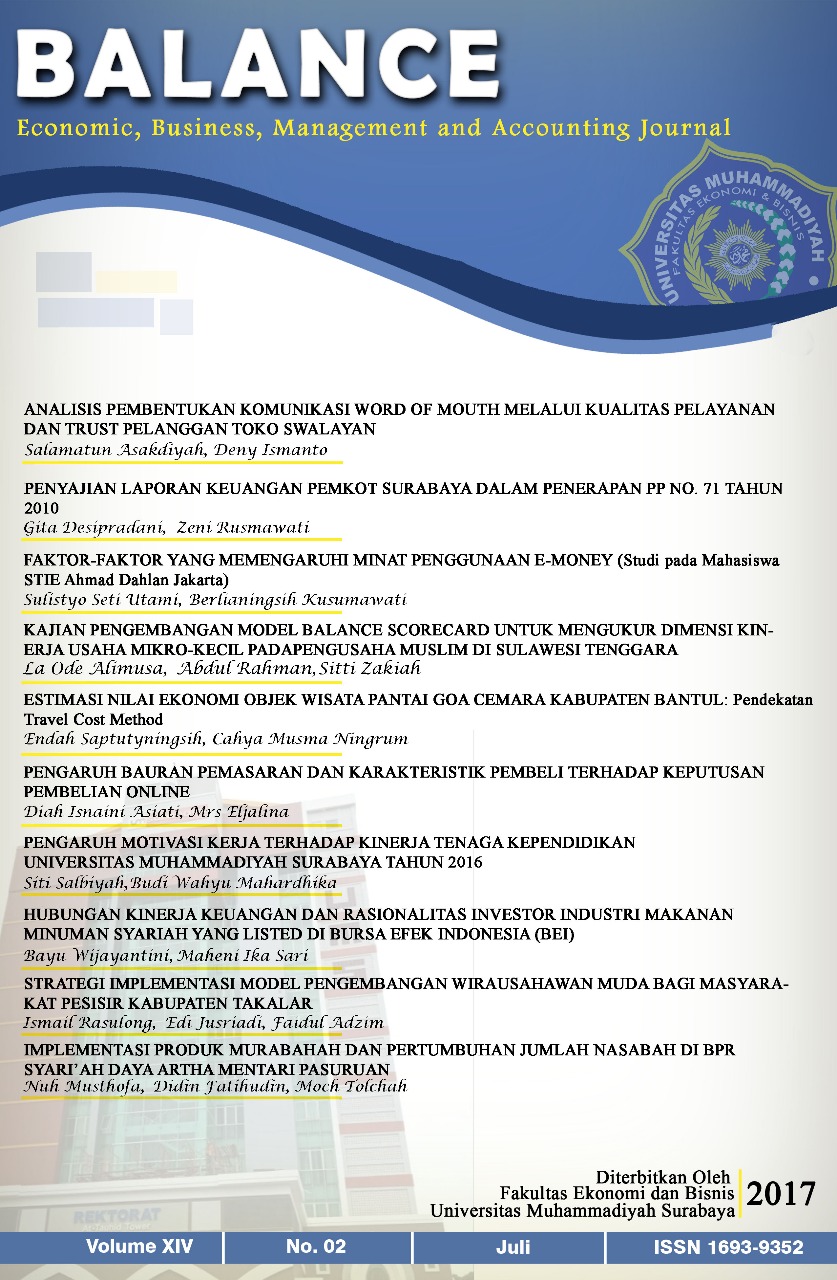ANALISIS PEMBENTUKAN KOMUNIKASI WORD OF MOUTH MELALUI KUALITAS PELAYANAN DAN TRUST PELANGGAN TOKO SWALAYAN
DOI:
https://doi.org/10.30651/blc.v14i02.1316Abstrak
ABSTRACTÂ
 This research aimed to test influence between service quality, customer trust also interaction between service quality and customer trust in the building of word of mouth communication of supermarket. This research efforted in Pamella Supermarket in Yogyakarta. Sample categorized with sampling convenience method and purposive sampling. Data collection efforted by giving list of question to the respondent that is contains about service quality, customer trust and word of mouth communication this research use moderator Regression Analysis. In the other side, T test and F test are used to test asked hypothesis.
This result of partially regression coefficient test with T test shows that service quality, customer trust also interaction between them influence significantly to word of mouth communications. In the other side coefficient regression with F test’s result shows that variables of service quality, customer trust also interaction between them both influence to word of mouth communication. Variable of service quality, customer trust also interaction between them are able to explain word of mouth communication variable up 81% and the rest is 19% caused by another variable that is not included in the research model.
Keyword : Service Quality, Customer Trust and Word of Mouth Communication.
Correspondence to : salamatun_2009@yahoo.com
Â
ABSTRAKÂ
Penelitian ini bertujuan untuk menguji pengaruh kualitas pelayanan, trust pelanggan serta interaksi antara kualitas pelayanan dan trust pelanggan dalam pembentukan komunikasi word of mouth. Penelitian dilakukan pada Pamella Swalayan di Kota Yogyakarta. Sampel ditentukan dengan metode convenience sampling dan purposive sampling. Pengumpulan data dilakukan dengan cara memberikan daftar pertanyaan kepada responden yang berisi tentang kualitas pelayanan, trust pelanggan serta komunikasi word of mouth. Alat analisis yang digunakan adalah Analisis Regresi Moderator. Sedangkan untuk menguji hipotesis yang dikemukakan digunakan uji t dan uji F. Uji t digunakan untuk menguji koefisien regresi secara parsial dan uji F digunakan untuk menguji koefisien regresi secara serempak (bersama-sama). Sedangkan untuk mengetahui seberapa besar variabel-variabel kualitas pelayanan, trust pelanggan serta interaksi antara kualitas pelayanan dan trust pelanggan mampu menjelaskan variabel komunikasi word of mouth digunakan analisis koefisien determinasi.
Hasil pengujian koefisien regresi secara parsial dengan uji t menunjukkan bahwa kualitas pelayanan, trust pelanggan serta interaksi antara kualitas pelayanan dengan trust pelanggan secara signifikan mempengaruhi komunikasi word of mouth.Sedangkan hasil pengujian koefisien regresi secara bersama-sama menunjukkan bahwa varaibel kualitas pelayanan, trust pelanggan serta interaksi antara kualitas pelayanan dengan trust pelanggan secara bersama-sama berpengaruh terhadap komunikasi word of mouth. Variabel-variabel kualitas pelayanan, trust pelanggan serta interaksi antara kualitas pelayanan dengan trust pelanggan mampu menjelaskan variabel komunikasi word of mouth sebesar 81%, dan sisanya sebesar 19% disebabkan oleh variabel lain yang tidak dimasukkan dalam model penelitian.
Kata Kunci    :Kualitas Pelayanan, Trust Pelanggan, dan Komunikasi
Word of Mouth
Korespondensi : salamatun_2009@yahoo.com
Referensi
Ancok, D. (1989), “Validitas dan Reliabilitas Instrumen Penelitian,†M. Singarimbun dan S. Effendi (ed.), Metodologi Penelitian Survai, Yogyakarta : LP3ES.
Arndt, J.(1967), “Word of Mouth Advertising and Informal Communication,†In D.F Cox (Ed.), Risk Taking and Information Handling Behavior, Bostom : Harvard University.
Azwar, S. (1997), Reliabilitas dan Validitas, Yogyakarta : Pustaka Pelajar.
Babbie, E. (1995), The Practice of Social Research, 7 th ed. Belmont : Wadsworth Publishing Company.
Berry, L.L. dan A. Parasuraman (1991), Marketing Service: Competing Through Quality, New York: The Free Press.
Berry, L.L. (1995), “Relationship Marketing of Service – Growing Interest. Emerging Perspective,†Journal of the Academy of Marketing Science, Vol. 23, No. 4, p. 236 – 245.
Borgida, E. dan E.E. Nisbett (1977), ‘The Differential Effect of Abstract vs Conerete Information Decisions,†Journal of Applied Social Psychology,Vol. 7, p. 258-271
Cooper, D.R. dan C.W. Emory (1995), Business Research Methods, 5 th ed., chicago : Richard D. Irwin Inc.
Coulter, K.S. dan R.A. Coulter (2002), “Determinant of Trust In a Service Provider: The Moderating Role of Length of Relationship,†Journal of Service Marketing, Vol. 16, No. 1, p. 35 – 50.
Cronin, J.J. dan S.A. Taylor (1992), “Measuring Service Quality; A Reaxamination and Extension.“ Journal of Marketing, July, p. 55 – 68.
Dabholkar, P.A., D.I. Thorpe dan J.O. Rentz (1996), “A Measure of Service Quality For Retail Store : Scale Development and Validation.“ Journal of The Academy Marketing Science, Vol. 24, No. 1, p. 3 – 16.
Day.R.L. dan E.L.Jr. Laudon (1977), “Toward a Theory of Consumer Complaining Behavior,†In Woodside, A.G. Sheth and P. Bennett (Eds.), Consumer and Industrial Buying Behavior, Nort Holland : Elseview
Dharmmesta, B.S. (1999), “Loyalitas Pelanggan: Sebuah Kajian Konseptual Sebagai Panduan Bagi Peneliti,†Jurnal Ekonomi dan Bisnis Indonesia, Vol. 14, No. 3, p. 73 – 88.
Dick, A.S. dan K. Basu (1994), “Customer Loyalty: Toward an Integrated Conceptual Framework,†Journal of The Academy of Marketing Science, Vol. 22, No. 2 (Spring), p. 99 – 113.
Fitzsimmons, J.A. dan M.J. Fitzsimmons (1994), Service Management For Competitive Advantage, New York : Mc. Graw – Hill Inc.
Garbarino, E., dan M.S. Johnson (1999), “Different Roles of Satisfaction, Trust, and Commitment In Customer Relationship,†Journal of Marketing, April, p. 70 – 86.
Gulati, R. (1995), “Does Familiarity Breed Trust? The Implications of Repeated Ties for Contractual Choices In Alliances,†Academy of Management Journal, January, Vol. 38, p. 85 – 112.
Hadi, S. (1987), Metodologi Research, Jilid I, Yogyakarta : Yayasan Penerbit Fakultas Psikologi UGM.
Hair, F.J.Jr. R.E. Anderson, R.L. Tatham dan W.G. Black (1995), Multivariate Data Analysis, With Reading, 4 th ed., USA : Prentice Hall International Inc.
Harrison, L.J. dan Walker (2001), “The measurement of Word of Mouth Communication and an Investigation of service Quality and customer Commitment as Potential Antecedents,†Journal of service Research, Vol. 4, NO. 1, August, p. 60-75.
Quality, Value, and Word-of-Mouth Intention, “Journal of Business Research,†Vol. 35, p. 207 – 215.
Huck, S.W. dan W.H. Cormier (1996), Reading Statistics and Research, 2nd ed,. New York : Harper Collins Publisher Inc.
Johnson, W.C. dan A. Sirikit (2002), “Service Quallity In The Thai Telecommunication Industry : A Tool For Achieving A Sustainable Competitive Advantage,“ Management Decision, Vol. 40, No. 7., p. 693 – 701.
Lau, G.T. dan S.H. Lee (1999), “Consumers Trust In Brand and The Link to Brand Loyalty,†Journal of Market Focused Management, No. 4, p. 341 – 370.
Mantra, I.B. dan Kasto (1989), “Penentuan Sampel,†M. Singarimbun dan S. Effendi (ed.), Metode Penelitian Survai, Yogyakarta : LP3ES
Mc. Dougall, G.H.G. dan T. Levesque (2000), “Customer Satisfaction With Service : Putting Perceived Value into The Equation,†Journal of Service Marketing, Vol. 14. No. 5, p. 392 – 408.
Moorman, C., G. Zaltman dan R. Desphande (1992), “Relationship Between Provider and User of Market Research: The Dynamic of Trust Within and Between Organization,†Journal of Marketing Research, Vol. 29, p. 314 – 328.
Parasuraman, A.,V.A. Zeithaml dan L.L. Berry (1985), “A Conceptual Model of Service Quality and Impliation of Future Research, “Journal of Marketing, Vol. 49, p. 41-55
_________ (1988), “SERVQUAL : A Multiple – Item Scale For Measuring Consumer Perceptions of Service Quality,†Journal of Retailing, Vol. 64, No. 1, p. 12-14.
Pritchard, M.P., M.E. Havits, D.R. Howard (1999), “Analyzing The Commitment – Loyalty Link In Service Contexts,†Journal of The Academy of Marketing Science, Vol. 27, No. 3, p. 333-348.
Rowley, J. dan Jl. Dawes (1999), “Customer Loyalty – a Relevant Concept for Libraries,†Library Management, Vol.20 (6), p. 345-351
Taylor, A.S. dan L.T. Baker (1994), “An Assessment of Realtionship Between Service Quality and Customer Satisfaction in The Formation of Consumers’ Purchase Intention, “Journal of Retailing. Vol. 70, No. 2, p.163-178.
Zeithaml, V.A., L.L. Berry dan Parasuraman (1996), “The Behavioral Consequences of Service of Service Quality, “Journal of Marketing, Vol. 60, p. 31-46.
Zulganef (2006), ‘The Existence of Overall Satisfaction In Service Customer Relationship,†Gadjah Mada International Journal of Business, Vol. 8, No. 3, p. 301-321.















